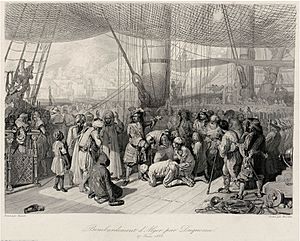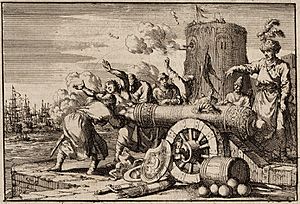Bombardment of Algiers (1683) facts for kids
Quick facts for kids Bombardment of Algiers, 1683 |
|||||||
|---|---|---|---|---|---|---|---|
| Part of French-Algerian War 1681-88 | |||||||
 Augustin Burdet, Duquesne liberating the captives after the bombardment of Algiers in 1683, engraving after François-Auguste Biard. |
|||||||
|
|||||||
| Belligerents | |||||||
| Commanders and leaders | |||||||
| Units involved | |||||||
| 17 ships of the line 3 frigates 16 galleys 7 bomb galiots 48 longboats 18 fluyts 8 tartans |
unknown | ||||||
The bombardment of Algiers in 1683 was a big naval attack by France against the city of Algiers. At this time, Algiers was part of the Ottoman Empire and known as the Regency of Algiers. This event was part of a larger conflict called the French-Algerian War 1681–88.
The main goal of the French attack was to stop Algerian pirates, also known as corsairs, from raiding French ships and coasts. It also aimed to free French prisoners held in Algiers. While some prisoners were rescued, many others remained captive.
| Top - 0-9 A B C D E F G H I J K L M N O P Q R S T U V W X Y Z |
Why did France attack Algiers?
In the years before 1683, there was a lot of tension between France and Algiers. The ruler of France, King Louis XIV, wanted to stop the Algerian corsairs. These pirates often captured European ships and took their crews as slaves.
In 1682, King Louis XIV had already ordered Admiral Abraham Duquesne to attack Algiers. Duquesne sailed with a large fleet, but bad weather made it hard to attack effectively. Even though the city was damaged, a peace agreement couldn't be reached. So, Duquesne had to go back to France.
Preparing for the Second Attack
In the spring of 1683, Admiral Duquesne prepared for another attack. He gathered an even bigger fleet than before. This fleet included:
- 17 large warships called ships of the line
- 3 smaller warships called frigates
- 16 galleys (ships powered by oars)
- 7 special ships called bomb galiots (these were designed to fire bombs)
- Many smaller boats and supply ships
The bomb galiots were much better equipped this time. They had special crews trained to fire the bombs. The entire fleet left the French port of Toulon on May 23, heading for Algiers.
The Bombardment Begins
The attack on Algiers started on the night of June 26–27, 1683. The French fired many bombs at the city. In less than 24 hours, over 200 bombs hit Algiers. This caused huge fires and a lot of chaos. About 300 Algerians were killed.
The ruler of Algiers, known as the Dey, was named Hassan Dey. He wanted to keep fighting, but the people of Algiers urged him to make peace. Duquesne agreed to a temporary stop in fighting, called a truce. His condition was that all Christian slaves had to be freed.
When the truce was about to end, Hassan Dey asked for more time, and Duquesne agreed. Duquesne then laid out his terms for a lasting peace:
- All Christian slaves must be freed.
- Algiers had to pay a large sum of money for all the goods taken by pirates from France.
- An official group from Algiers had to go to France to apologize to King Louis XIV for attacking his navy.
These demands were very strict. Hassan Dey decided that he could not agree to them and chose to continue fighting.
A Change in Leadership
During this time, one of the Algerian commanders, Mezzo Morto Hüseyin Pasha, became very angry with Hassan Dey. He thought the Dey was a coward for trying to make peace with the French. Mezzo Morto took control and had Hassan Dey killed. The soldiers, called janissaries, then made Mezzo Morto their new leader.
Soon after, a red flag was raised over the Casbah, the old fortress in Algiers. This was a signal to Duquesne that the fighting was back on. The Algerians responded to the French bombs in a terrible way. They tied the French consul, Jean Le Vacher, and other French prisoners to the mouths of cannons. Then, they fired the cannons. This was a brutal act meant to scare the French.
Despite the fierce resistance, the city of Algiers was badly damaged. Huge fires spread, destroying palaces, mosques, and many other buildings. Wounded people had nowhere safe to go, and Algiers was running out of ammunition. The city might have been completely destroyed if Duquesne hadn't also run out of bombs. The bombardment finally ended on July 29.
Even though the French caused a lot of damage, King Louis XIV did not achieve all his goals. He couldn't completely destroy Algiers, nor could he force the Algerians to agree to all his demands for peace.
What Happened Next?
In 1684, King Louis XIV sent another French admiral, Anne Hilarion de Tourville, to Algiers. This time, a peace treaty was signed. This treaty mostly kept the rules from earlier agreements.
However, peace didn't last forever. Five years later, Algiers broke the treaty. So, the French attacked the city again in 1688, led by Admiral d'Estrées. This attack forced the Dey of Algiers to sign a new peace agreement on September 27, 1688. This time, the Algerians respected the treaty.
After this, the corsair captains from Algiers generally avoided attacking French ships and coasts. However, they continued their raids in other areas, causing a lot of damage to the coastal regions of Spain.
See also


